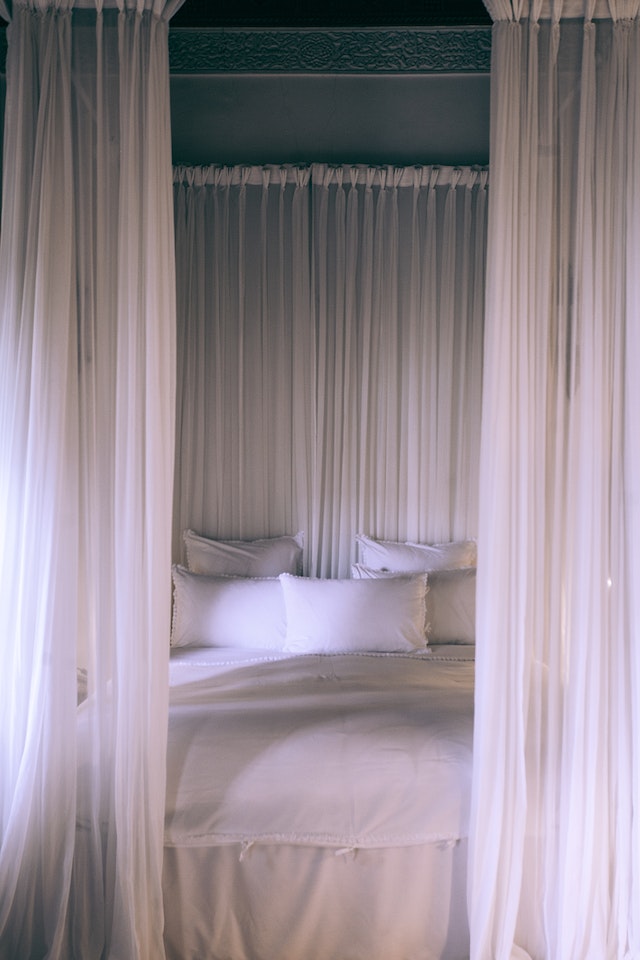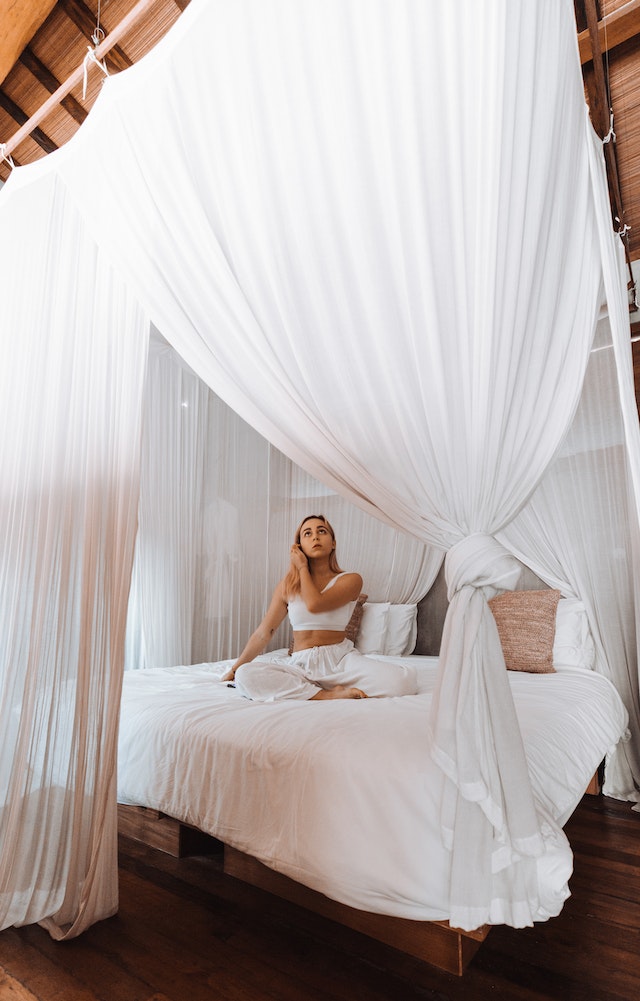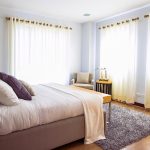A bed canopy, also known as a bed crown or canopy bed curtains, is a decorative and often functional drapery or framework that surrounds a bed. The design traces its origins back to ancient civilizations and has since evolved into various styles and purposes. Today, bed canopies are used for aesthetics, privacy, and protection. This article delves into the history, styles, and benefits of bed canopies.
Contents
Historical Context
The use of bed canopies can be traced back to ancient civilizations such as the Egyptians and Greeks. In these times, canopies were largely functional, offering protection against insects and providing privacy. The affluent members of society usually owned elaborate canopies, which were considered symbols of wealth and status.
During medieval times, the European nobility took to using canopies to emphasize their social standing. These canopies were ornate and were usually accompanied by heavy curtains to retain warmth and ensure privacy.
Styles and Designs
- Traditional Four-Poster Canopy Bed: These have four vertical columns, one in each corner, which support the upper rectangular frame from which fabrics or netting might hang. The fabric may be draped over the top or hung from the sides to enclose the bed.
- Circular Canopy: Typically suspended from a ceiling hook, these are draped around the bed and often used in children’s bedrooms or for cribs, imparting a fairy-tale appearance.
- Half Canopy: This type originates from the headboard and covers only the head of the bed, creating a cozy nook.
- Crown or Teester Canopy: A decorative piece fixed to the wall or ceiling from which fabric cascades.
Materials
Bed canopies can be made from a diverse range of materials. Lightweight fabrics such as tulle, silk, or netting are popular for decorative purposes. For functional uses, like protection from mosquitoes in tropical climates, a more closely-woven fabric or mosquito netting is preferred.
Benefits of a Bed Canopy
- Aesthetic Appeal: The immediate allure of a bed canopy is its transformative effect on a bedroom’s aesthetics. Depending on the chosen material and design, it can offer a romantic, luxurious, or whimsical touch.
- Protection: In regions where insect-borne diseases are prevalent, bed canopies (especially mosquito nets) are crucial. They provide a protective barrier against harmful insects.
- Privacy: In shared sleeping spaces, canopies can offer a semblance of privacy.
- Warmth: Historically, heavy draperies were used to keep the sleeping area warm, a benefit that can still be relevant in cold climates.
From being a symbol of status in ancient times to serving functional and aesthetic purposes today, bed canopies have come a long way. Whether you’re looking to upgrade your bedroom’s aesthetic, seeking some added privacy, or simply want to keep bugs at bay, a bed canopy is a timeless choice that combines functionality with style.
Are Bed Canopies a Good Idea?
Whether or not a bed canopy is a good idea depends on individual preferences, needs, and the environment in which one lives. Here’s a breakdown of the pros and cons to help you decide:
Pros of Bed Canopies:
- Aesthetic Enhancement: Canopies can elevate the aesthetic of a bedroom, making it appear more elegant, romantic, or whimsical. Depending on the design and material, they can transform the room’s ambiance entirely.
- Protection: In areas prone to mosquitoes or other flying insects, a bed canopy, especially when made of mosquito netting, can offer protection against bug bites. This is crucial in regions where insect-borne diseases, such as malaria or dengue fever, are prevalent.
- Privacy: For those sharing a bedroom or living in studio apartments, a bed canopy can create a semblance of privacy.
- Warmth: Historically, canopies with heavy curtains were used to retain warmth in colder climates. They can still serve this function in modern homes, making the bed area feel cozier during winter.
- Sensory Shelter: For some individuals, particularly children or those with sensory processing disorders, a canopy can offer a comforting, enclosed space, reducing sensory overload.
Cons of Bed Canopies:
- Maintenance: Fabric canopies can accumulate dust, which may trigger allergies. Regular cleaning is essential, which can be cumbersome for some.
- Safety Concerns: In homes with small children or pets, there’s a risk associated with cords or fabrics. Children might pull them down, or they might become entangled, posing a safety hazard.
- Space Consuming: In smaller bedrooms, a canopy might make the space feel more confined or cluttered.
- Cost: High-quality canopies, especially those made from luxurious fabrics or intricate designs, can be expensive.
- Installation Issues: Some canopies, especially those that hang from ceilings, might be challenging to install, requiring drilling or the use of specific hardware.
Bed canopies can be a delightful addition to many bedrooms, but they’re not for everyone. Before investing in one, it’s essential to consider the specific needs of the room’s occupants, the room’s size, and the local environment. If the benefits such as aesthetics, protection, or warmth are appealing and outweigh the potential cons for you, then a bed canopy could be a great idea for your space.
Why is it called a canopy bed?
The term “canopy bed” has historical and descriptive origins that date back several centuries. To fully understand why it’s called a canopy bed, we need to break down the term and delve into its evolution.
Origins of the Canopy Bed
- Functional Beginnings: Canopy beds originated in Medieval Europe as a means of providing warmth and privacy. These beds, usually owned by the nobility or the affluent, were fully curtained to retain heat and offer seclusion, especially when multiple people shared a single room or living space.
- Structural Design: The primary characteristic of a canopy bed is the overhead canopy, typically made of fabric. This canopy is suspended from a frame, which either extends from the four posts of the bed or is attached to the ceiling.
Meaning and Etymology
The word “canopy” derives from the Medieval Latin word “conopeum,” which in turn has its roots in the Greek word “kōnōpion,” meaning a bed with mosquito curtains. Essentially, a “canopy” refers to a covering or an overhead shade, whether it’s for beds, thrones, or other structures. When attached to the term “bed,” it specifically denotes a bed with an overhead covering.
Given its functional and structural attributes, a bed with an overhead fabric or drapery naturally came to be known as a “canopy bed.”
Evolution Over Time
While the initial uses of the canopy bed were primarily functional, as time progressed, these beds became more ornate and decorative, especially during the Renaissance period. The canopy and curtains were often made of luxurious fabrics, richly embroidered and sometimes even adorned with jewels.
In modern times, while many people still value the warmth and privacy offered by a canopy bed, others simply appreciate the aesthetic and decorative qualities that transform an ordinary bedroom into a dreamy, elegant space.
The term “canopy bed” is rooted in the idea of an overhead covering or protection, both in function and form. As history progressed, the canopy bed transitioned from being purely functional to also serving as a symbol of luxury, status, and artistic expression. The name aptly captures the essence of its design and purpose.
What is the purpose of a canopy?
The term “canopy” can apply to various contexts, from natural environments to architectural and design elements. Depending on its application, a canopy serves multiple purposes. Here’s an overview of the various purposes of canopies:
Architectural & Design Canopies:
- Protection from Elements: Canopies, such as those over entrances of buildings or over outdoor patios, provide shelter from rain, sun, and snow.
- Aesthetics: In architectural design, canopies can be decorative elements that enhance the facade of a building or add a touch of elegance to an outdoor setting.
- Indication of Entrance: Canopies over building entrances signify where the primary access points are, guiding visitors or patrons.
Natural Canopies:
- Habitat: In forests, the canopy layer refers to the uppermost layer of vegetation, where the tallest trees extend their branches. This layer provides habitat for various animals and plants.
- Temperature Regulation: The canopy layer plays a role in regulating temperature beneath it by providing shade and reducing the impact of direct sunlight.
- Moisture Retention: Forest canopies influence the rainwater’s distribution, allowing some to drip down gradually, which benefits the underlying vegetation.
Bed Canopies:
- Aesthetics: Canopies can transform the appearance of a bedroom, adding a touch of luxury, romance, or whimsy.
- Privacy: In shared sleeping quarters, canopies can offer an added layer of privacy.
- Protection: Canopies, especially those made of mosquito netting, protect against insects in areas where insect-borne diseases are prevalent.
- Warmth: Historically, canopies with draperies were used to retain warmth in the sleeping area, a feature still appreciated in colder climates.
Vehicle Canopies:
- Protection: Canopies on vehicles, such as convertibles or certain aircraft, protect occupants from the elements.
- Aerodynamics: In aircraft, a canopy might be designed to streamline the vehicle’s shape, reducing drag and improving performance.
Event Canopies or Tents:
- Shelter: For outdoor events, canopies provide shelter from the sun, rain, or other elements, ensuring that the event can proceed regardless of weather conditions.
- Designation of Space: In large open areas, canopies can demarcate specific zones or areas for particular activities or stalls.
Commercial Canopies (e.g., Street Vendors):
- Protection: They safeguard goods from direct sunlight, rain, or other environmental factors.
- Attract Customers: A well-designed canopy can draw attention and potentially attract more customers.
The primary purposes of canopies, irrespective of their context, revolve around protection, designation of space, and aesthetic enhancement. The specific purpose in any given situation will depend on the type of canopy and its intended function.
Tips for care bed canopy
Proper care for your bed canopy ensures it remains clean, functional, and aesthetically pleasing for a long time. Here are some tips to help you maintain and care for your bed canopy:
Regular Dusting:
- Use a long-handled duster to gently remove dust from the canopy, especially if it’s a fixed or non-washable type. This prevents the accumulation of allergens and maintains a fresh appearance.
Check Care Labels:
- Always refer to the manufacturer’s care label before cleaning. Some fabrics may have specific requirements or restrictions.
Gentle Washing:
- If the fabric is washable, use cold or lukewarm water and a gentle cycle. Avoid harsh detergents, as they can damage delicate fabrics or fade colors.
Hand Wash Delicate Fabrics:
- Materials like silk, tulle, or lace might require hand washing. Use a mild detergent and ensure you rinse thoroughly.
Avoid Bleach:
- Bleach can weaken fibers and cause discoloration. If you need to treat a stain, use a gentle fabric cleaner or spot-treat carefully.
Air Dry:
- It’s usually best to air dry your canopy to prevent shrinkage and fabric damage. If possible, hang it in a shaded area to prevent color fading from direct sunlight.
Ironing:
- If your canopy has wrinkles, use a low heat setting on your iron. For delicate fabrics, consider using a steamer or place a cloth between the iron and the canopy to prevent direct contact.
Regular Inspection:
- Periodically check the canopy for signs of wear, tear, or damage. Addressing minor issues promptly can prevent them from worsening.
Rotate If Needed:
- If your canopy experiences uneven wear (from sunlight exposure or frequent touching), consider rotating it periodically to ensure even wear and prolong its life.
Storage:
- If you’re not using your canopy for an extended period, store it in a cool, dry place. Consider using a breathable fabric bag to protect it from dust.
Protect from Pests:
- Ensure the room is free from pests like moths that can damage the fabric. Using natural repellents like cedar or lavender can help keep these pests at bay.
Avoid Overburdening:
- If your canopy is hung from a frame or the ceiling, avoid adding heavy decorative items that could strain or damage it.
Immediate Stain Treatment:
- If the canopy gets stained, treat it immediately. Blot (don’t rub) the stain with a clean cloth and use a suitable fabric cleaner.
Professional Cleaning:
- For intricate or very delicate canopies, or those made from unique materials, consider getting them professionally cleaned.
Regular care and maintenance can significantly extend the life of your bed canopy, ensuring it remains a beautiful and functional addition to your bedroom for years to come.
Tricks for buying bed canopy
When buying a bed canopy, it’s essential to consider several factors to ensure you get the best value and a product that suits your needs. Here are some tricks and tips to guide you:
Measure Twice, Buy Once:
- Ensure you measure the dimensions of your bed and the room before purchasing. Know whether you want the canopy to extend to the floor, just drape above the bed, or have a particular drop length.
Material Matters:
- Consider the canopy’s material. If you’re looking for mosquito protection, a fine mesh is essential. For a luxurious touch, materials like silk or velvet are ideal.
Check the Installation Process:
- Some canopies require ceiling hooks, while others might need a frame or can be mounted on the wall. Ensure the installation method suits your living situation, especially if you’re renting and can’t put holes in the ceiling.
Read Reviews:
- Previous buyers can offer insights into the product’s quality, ease of installation, and actual appearance. Look for reviews with pictures to see how the canopy looks in real-life settings.
Consider the Cleaning Process:
- Check care instructions. Machine-washable canopies might be more convenient than those requiring hand-washing or professional cleaning.
Aesthetics:
- Visualize how the canopy will look in your room. Consider the color, design, and style. Some online stores offer virtual try-ons or room visualizers to help you decide.
Safety First:
- If buying for a child’s room, ensure the canopy doesn’t pose a choking or strangulation hazard. Also, ensure that the material is flame retardant.
Budget Wisely:
- Canopies are available in various price ranges. Set a budget but be ready to adjust slightly if you find a canopy that ticks all your boxes. Remember, you often get what you pay for.
Brands and Warranties:
- Trusted brands may offer better quality and customer service. Check if the canopy comes with a warranty or satisfaction guarantee.
Customizable Options:
- Some suppliers may offer customization options, allowing you to pick the material, design, or even add embellishments to your liking.
Return Policy:
- Ensure the store or online platform has a friendly return policy. In case the canopy doesn’t fit or match your expectations, you should be able to return or exchange it with ease.
Check for Deals:
- Keep an eye out for sales, discounts, or bundled deals, especially during holiday seasons or special sale events. You might snag a high-quality canopy at a fraction of its usual price.
By keeping these tricks in mind, you’ll be better prepared to select a bed canopy that enhances your room’s aesthetics, fulfills your functional needs, and offers good value for your money.
Example of bed canopy
Bed canopies come in a variety of styles and designs. Below is a descriptive example of a bed canopy:
Elegant Four-Poster Bed Canopy
Design & Structure:
The bed canopy boasts a four-poster design, with each corner of the bed extending upward in beautifully carved wooden posts. These posts reach a height of about seven feet, culminating in ornate finials.
At the top, connecting these four posts, is a rectangular wooden frame, creating a solid base for draping fabrics. Each post is sturdy, ensuring stability and durability, and is polished to a glossy finish that accentuates the wood’s natural grain.
Fabric:
Draped gracefully over the rectangular frame is a soft, flowing fabric, reminiscent of sheer silk. The canopy’s fabric is a dreamy off-white, allowing diffused light to pass through, which bathes the bed in a gentle, ambient glow.
The fabric is long enough to cascade down each of the four corners, touching the floor with a slight puddle of excess material. The sheer nature of the fabric ensures that while it provides a semblance of privacy, it doesn’t make the bed feel too enclosed or heavy.
Additional Features:
Interspersed across the canopy fabric are delicate hand-stitched patterns, resembling climbing vines and blooming flowers. These patterns, subtle yet intricate, add a touch of sophistication and luxury to the canopy.
At the head of the bed, two longer pieces of the same fabric can be drawn back and tied with tasselled ropes, creating an inviting open entrance to the bed while maintaining the canopy’s romantic ambience.
Setting:
Paired with a plush bed set, including an oversized down comforter and an array of decorative pillows, the entire setup looks fit for royalty. The canopy adds height to the room, drawing eyes upward and emphasizing the room’s spaciousness. In the dim light of the evening, with a few candles lit, the bed, draped in its elegant canopy, becomes an oasis of comfort and luxury.
This example paints a picture of a classic and luxurious bed canopy. There are many other styles and designs available, catering to a variety of tastes, room sizes, and functional requirements.
A size chart Table of bed canopy
A bed canopy’s size often correlates with the size of the bed itself. Here’s a simplified size chart table for bed canopies based on standard bed sizes. Note: Actual canopy dimensions may vary based on the style, design, and manufacturer.
+—————-+——————+
| Bed Size | Canopy Dimensions|
+—————-+——————+
| Twin | 39″ x 75″ |
+—————-+——————+
| Twin XL | 39″ x 80″ |
+—————-+——————+
| Full (Double) | 54″ x 75″ |
+—————-+——————+
| Queen | 60″ x 80″ |
+—————-+——————+
| King | 76″ x 80″ |
+—————-+——————+
| California King| 72″ x 84″ |
+—————-+——————+
A few things to remember:
- Height: This chart provides dimensions for length and width. The height of a canopy varies based on design. Some canopies might just cover the bed’s top, while others drape down to the floor. You’ll need to measure the height from the ceiling to the floor or the height of the bedposts if considering a four-poster bed.
- Draping: For canopies that drape down, you might want extra fabric for a luxurious feel. This means the canopy’s dimensions, especially in terms of width and length, could exceed the actual dimensions of the bed.
- Custom Beds: If you have a non-standard bed size, you might need a custom canopy or adjust a standard size to fit.
Always measure your bed and room space accurately before purchasing a bed canopy to ensure a proper fit.
Price chart in 2023 bed canopy
The price of a bed canopy can vary widely based on several factors:
- Material: Canopies made of high-quality materials like silk or designer fabrics tend to be more expensive than those made of cotton or synthetic materials.
- Brand: Designer brands or well-known manufacturers may price their products higher than generic or lesser-known brands.
- Design: Intricate designs, hand-stitched patterns, or special embellishments can increase the cost.
- Size: Larger canopies for king-sized or custom beds will generally be more expensive than those for twin or full-sized beds.
- Features: Additional features like added mosquito netting, reinforced edges, or UV protection can also impact the price.
To get accurate and up-to-date pricing for bed canopies in 2023, I’d recommend checking online retailers, and home decor stores, or contacting manufacturers directly.

Frequently Asked Questions about bed canopy
Here’s a list of Frequently Asked Questions (FAQs) about bed canopies:
How do I install a bed canopy?
Installation methods vary. Some canopies are designed to hang from the ceiling using hooks, while others are designed for four-poster beds and drape over the frame. Always refer to the manufacturer’s instructions for specific installation steps.
Do I need a four-poster bed to have a canopy?
No, there are many canopy designs available that can be hung from the ceiling or attached to the wall, allowing you to create a canopy effect without a four-poster bed.
Will a bed canopy keep mosquitoes away?
Yes, if it’s a mosquito net canopy. These are made from fine mesh material designed to prevent mosquitoes and other insects from reaching the bed’s occupant.
How do I clean and maintain my bed canopy?
Cleaning methods depend on the canopy material. Many fabric canopies can be machine washed on a gentle cycle, but always check the care label. Some may require hand washing or professional cleaning.
Can a bed canopy be used in a child’s room?
Yes, but ensure it’s securely fastened and out of reach to prevent any potential hazards. It’s also essential to check regularly for wear and tear if it’s in a child’s room.
Does a canopy make a bed feel warmer?
Historically, canopies helped retain warmth. While modern homes often have heating systems, a canopy can still provide a cozy feeling by trapping a bit of warmth and reducing drafts.
Can I customize my bed canopy?
Yes, many people add lights, tassels, or other decorations to their canopies. Ensure any additions are securely fastened and don’t pose a fire hazard, especially if adding lights.
What materials are bed canopies typically made from?
Common materials include cotton, polyester, silk, tulle, and mesh. The choice often depends on the canopy’s purpose, whether decorative or functional (like mosquito protection).
Can a bed canopy be used outdoors?
Some canopies are designed for outdoor use, especially those meant for daybeds or lounges. Ensure the material is suitable for outdoor conditions and is secured to handle wind.
Will a canopy fit on a loft or bunk bed?
It depends on the design. Some canopies are specifically made for bunk or loft beds, but always measure the space and check the product specifications before purchasing.
For more in-depth answers or specific concerns, it’s always a good idea to consult with the retailer or manufacturer of the bed canopy.
Conclusion
History of Canopy Beds. Bed canopy have evolved over centuries, transitioning from functional necessities in medieval times to ornate symbols of luxury in later periods and now to diverse items that can either be decorative centrepieces or practical installations in contemporary homes. With their ability to transform a bedroom’s ambience, provide a sense of privacy, and even offer protection from pests, these canopies serve multiple purposes.
Whether you’re aiming for a romantic touch, a bohemian vibe, or a safe haven from insects, a bed canopy can be your answer. They cater to various tastes, from minimalistic and modern to luxurious and elaborate. The ease of installation and the availability of various styles make them suitable for almost every bedroom, regardless of size or theme.
The bed canopy, an age-old decor element, remains relevant in modern times, proving its timeless appeal. As a blend of form and function, it adds both aesthetic and practical value to the bedroom, making it a worthy consideration for anyone looking to elevate their sleeping space.







